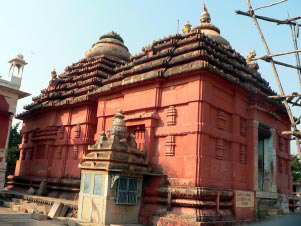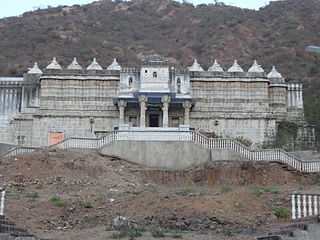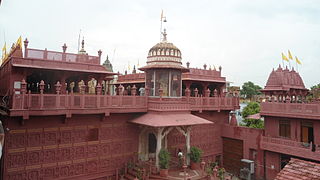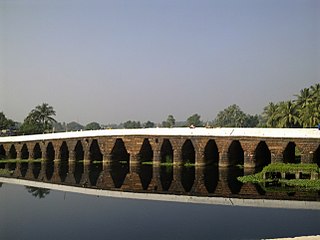| This article is part of a series on |
| Odisha |
|---|
 |
| Governance |
| Topics |
| Districts Divisions |
| GI Products |
This article lists monuments and sites of historic importance in Odisha, India.
| This article is part of a series on |
| Odisha |
|---|
 |
| Governance |
| Topics |
| Districts Divisions |
| GI Products |
This article lists monuments and sites of historic importance in Odisha, India.
| Site | Date(s) | Picture | Location | Description | References |
|---|---|---|---|---|---|
| Gudahandi | c. 20000 BCE | Kalahandi district | Rock paintings from Upper Paleolithic. | ||
| Vikramkhol | c.3000 BCE | Jharsuguda | Prehistoric human rock shelter with inscriptions. | [1] |
Singhapura (In Jajpur Dist): Some historians said that it was the capital of Singha Bahu, a Kalinga King who was contemporary of Lord Buddh and Bimbisar of Rajgrih. His exiled son Prince Vijaya established Sinhalese dynasty in Sri Lanka. The Archaeological Survey of India has been requested to excavate this site to unravel the truth.
| Site | Date(s) | Picture | Location | Description | References |
|---|---|---|---|---|---|
| Dhauli | 262 BCE |  | Dhauli, Bhubaneswar | Site of the Kalinga War | [2] |
| Sisupalgarh | c.300 CE |  | Bhubaneswar 20°13′35.9″N85°51′11.0″E / 20.226639°N 85.853056°E | Ancient fort | [3] |
| Asurgarh | c.9th century BCE | Kalahandi | Asurgarh is an archaeological site in the Kalahandi district of Odisha, India. Asurgarh is one of the sites which has its beginning in around 8th-9th century BC and emerged as one of the early urban fortified settlements in the region and it is older than Sisupalgarh. Archaeologists have unearthed artefacts believed to be 2,300-year-old while carrying out excavation at the Asurgarh Fort in Odisha’s Kalahandi district. DB Gadanayak, Archaeological Survey of India, says Asurgarh is one of the sites which has its beginning in around 8th-9th century BC and emerged as one of the early urban fortified settlements in the region by the efforts of tribal and non-tribal inhabitants of the region. [4] Lokesh Durga, Department of History of Delhi University, says Asurgarh settlement is older than Sisupalgarh and the first Urbanization process in Odisha started from Asurgarh. [5] [6] [7] | [8] [9] | |
| Bindusagar Tank | c. 7-8th century CE |  | Old Town, Bhubaneswar | A ritual tank with a shrine in the centre. | [10] |
| Chausath Yogini Temples | c. 9th century CE |  | Jharial, Bolangir | A hypaethral temple for 64 yoginis | [11] |
| Chausathi Jogini Temple | 9th century CE |  | Hirapur, Khurda | Hypaethral temple for 64 Yoginis in the outskirts of Bhubaneswar | [12] |
| Anantashayana Vishnu | 9th century CE |  | Sarang, Dhenkanal | 15 metre long rock cut image of Vishnu lying in rest. | [13] |
| Site | Date(s) | Picture | Location | Description | References |
|---|---|---|---|---|---|
| Ratnagiri | c.10th century |  | Jajpur | Buddhist monastery built by the Bhauma-Kara dynasty | [14] |
| Lalitgiri | c.10th century |  | Cuttack | A group Buddhist monasteries. | [15] |
| Brahmeswara Temple | 1058 CE |  | Bhubaneswar | Shiva temple built during reign of the Somavamsis | [16] |
| Jagannath Temple | c.1090 |  | Puri | Vaishnava temple built by Eastern Ganga dynasty kings. | [17] |
| Lingaraja Temple | c.1100 |  | Bhubaneswar | Shiva temple built by Somavamsi kings. | [18] |
| Gundicha Temple | 12th century |  | Puri | Built by the Eastern Ganga dynasty. Houses the main idols during the Ratha Yatra festival. | [19] [20] |
| Barabati fort | c. 1230 |  | Cuttack | Presumed to have been built by Anangabhimadev III of the Eastern Ganga dynasty | [21] |
| Kapilash Temple | 1246 |  | Dhenkanal | Shiva temple constructed by Narasingha Deva I. | [22] |
| Konark Sun Temple | c. 1250 |  | Konark | Supposedly built by king Narasingha Deva I of Eastern Ganga Dynasty around 1250. | [23] |
| Ananta Vasudeva Temple | c.1278 |  | Bhubaneswar | Vaishnava temple built by Queen Chandrika, daughter of Anangabhimadeva III, of the Eastern Ganga dynasty | [17] [24] |
| Atharanala Bridge | c.1300 |  | Puri 19°49′11″N85°49′54.1″E / 19.81972°N 85.831694°E | Bridge with 18 arches, purportedly built by Narasingha Deva II of Eastern Ganga Dynasty. | [25] |
| Biraja Temple, Jajpur | 13th Century | Built originally by Jajati Keshari of Soma Dynasty | |||
| Annakoteshvara Temple | 16th Century | Latadeipur, Gondia, Dhenkanal | Shiva temple built during the reign of the Gajapati dynasty | [26] [27] | |
| Alarnath Temple | 1610 AD | Brahmagiri, Puri, 752011 | [28] | ||
| Baladevjew Temple | 1707 |  | Kendrapara | Temple built during Maratha occupation of Odisha. | [29] |
| Qadam-e-Rasool | 1718 | Cuttack | Mosque built by Shuja-ud-Din Muhammad Khan. Purportedly contains a Qadam Rasul (footprint of Muhammad). | [30] |
| Site | Date(s) | Picture | Location | Description | References |
|---|---|---|---|---|---|
| Joranda Gadi | Early 20th century |  | Joranda, Dhenkanal | Contains the samadhi of the founder of the Mahima Dharma sect. | [31] |
| Inchudi | 1930 | Balasore | Site of Salt Satyagraha in the state. | [32] |

Puri is a coastal city and a municipality in the state of Odisha in eastern India. It is the district headquarters of Puri district and is situated on the Bay of Bengal, 60 kilometres (37 mi) south of the state capital of Bhubaneswar. It is home to the 12th-century Jagannath Temple and is one of the original Char Dham pilgrimage sites for Hindus.

Indira Gandhi National Centre for the Arts (IGNCA), New Delhi is a premier government-funded arts organization in India. It is an autonomous institute under the Union Ministry of Culture.

The Jagannath Temple is an important Hindu temple dedicated to Jagannath, a form of Vishnu–one of the trinity of supreme divinity in Hinduism. It is located in Puri in the state of Odisha, situated on the eastern coast of India. As per temple records, the mythical King Indradyumna of Avanti built the main temple of Jagannath at Puri. The present temple was rebuilt from the tenth century onwards, on the site of the pre-existing temples in the compound, but not the main Jagannath temple, and begun by Anantavarman Chodaganga, the first king of the Eastern Ganga dynasty. Many of the temple rituals are based on Oddiyana Tantras which are the refined versions of Mahayana Tantras as well as Shabari Tantras which are evolved from Tantric Buddhism and tribal beliefs respectively. The local legends link the idols with aboriginal tribes and the daitapatis (servitors) claim to be descendants of the aboriginals. The temple is one of the 108 Abhimana Kshethram of the Vaishnavite tradition.

Udayagiri and Khandagiri Caves, formerly called Kattaka Caves or Cuttack caves, are partly natural and partly artificial caves of archaeological, historical and religious importance near the city of Bhubaneswar in Odisha, India. The caves are situated on two adjacent hills, Udayagiri and Khandagiri mentioned as Kumari Parvata in the Hathigumpha inscription. They have a number of finely and ornately carved caves built during the 1st century BCE. It is believed that most of these caves were carved out as residential blocks for Jain monks during the reign of King Kharavela. Udayagiri means "Sunrise Hill" and has 18 caves while Khandagiri has 15 caves.
Sisupalgarh or SisupalagadaOdia:[sisupaːl̪ɔɡɔɽɔ] is situated in Khurda District in Odisha, India, and houses ruined fortifications. First inhabited around 7th to 6th centuries BCE, it is one of the largest and best-preserved early historic fortifications in India, and was once the capital of ancient Kalinga. It is identified with Kalinganagara of Kharavela and Tosali of Ashoka.
Tosali or Toshali was an ancient city in the present day Odisha state in eastern India. It was the capital of the eastern province of the Kalinga Kingdom. While some scholars tried to identify this ancient city with Dhauli, 7 km away from Bhubaneshwar, other scholars were inclined to identify this city with Shishupalgarh, 5 km away from Bhubaneshwar.

Bhattarika Temple is located on the bank of Mahanadi River, at Sasanga village in the tehsil Baramba,, Cuttack district, Odisha, India. It is dedicated to the Hindu Goddess Maa Bhattarika worshipped as a manifestation of Shakti. As per the Puranic tradition, Parashurama, facing certain defeat at the hands of Saharsrajuna, prayed to Durga who appeared on this spot to impart her divine power to his aid. The festival Pana Sankranti is celebrated here in April, Akshaya Tritiya in May and Dussehra in October.
The history of Kalahandi goes back to the primitive period where a well-civilized, urbanized, and cultured people inhabited this land mass around 2000 years ago. The world's largest celt of Stone Age and the largest cemetery of the megalithic age have been discovered in Kalahandi. This shows the region had a civilized culture since the pre-historic era. Asurgarh near Narla in Kalahandi was one of the oldest metropolises in Odisha whereas the other one was Sisupalgarh near Bhubaneswar. Some other historical forts in the region includes Budhigarh, Amthagarh, Belkhandi and Dadpur-Jajjaldeypur. This land was unconquered by the great Ashoka, who fought the great Kalinga War, as per Ashokan record. In medieval period the region had played a prominent role to link South India, Eastern India and Central India region and witnessed the battle ground for Somavamsi, Chola, Kalachuris of Kalyani and Eastern Ganga dynasty. Kalahandi region was the main route for Chola to attack Subarnapur.

Yameshwar or Jameshwar Temple is a very old temple dedicated to Shiva being worshiped by Yama. It is situated in Bhubaneswar, Odisha, India, near Bharati Matha, in Jameshwar Patna.

Annakoteshwara Temple, Annakoteswar Temple, or Annakotisvara Siva Temple is located in Latadeipur in Gondia tehsil in Dhenkanal district, Odisha, India. The Temple is dedicated to Lord Shiva with a stone shivalinga.
Asurgarh is an archaeological site in the Kalahandi district of Odisha, India. Asurgarh is one of the sites which has its beginning in around 8th-9th century BC and emerged as one of the early urban fortified settlements in the region and it is older than Sisupalgarh.

Digambara Jaina Temple is a Jain temple in Bhubaneswar, in the state of Odisha, India. The temple is on the top of Khandagiri hill. This hill is honeycombed with a series of rock-cut Jaina caves, commissioned by King Kharavela in the 1st century BCE. The rock-cut caves are protected by Archaeological Survey of India. The enshrining deities are a series of Jaina tirthankara images.

The Varahanatha Temple, also known as Yajna Varaha Temple, is a Hindu temple complex, located on the left bank of the Vaitarani River on an island formed by the river, in Jajpur, Odisha, India. The main shrine is dedicated to Varaha, the boar avatar of the god Vishnu. Built in 15-16th century, the temple is constructed in Kalinga architectural style. Besides the central Varaha shrine, there are numerous subordinate shrines to deities like Shiva, Vishnu, Vimala and others.

Mirpur Jain Temple is situated in Mirpur, a fortified village in the Sirohi district of Rajasthan, India. The village has four Jain temples.
Niali is a Tehsil headquarter in Cuttack district of Odisha. It is famous for the shrine of Sobhaneswar, a Shiva Temple. Niali is situated at a distance of 42 km from Cuttack, the district headquarters.

Shri Digamber Jain Atishya Kshetra Mandir, Sanghiji is an ancient Jain Temple in Sanganer, Rajasthan made of red stone. The ancient Shri Digamber Jain temple of Sanganer is 16 km from Jaipur.

Khajuresvara temple complex is a group of deula-complex in Odisha, India. These Buddhist and Shaiva-Shakta temple complex is localed at Khajurasahi, Sergarh, Balasore. The Deula complex was built during 9-10th CE. There are several stone idols found to be placed in each of the deula. The largest deula, Khajuresvara, has been devastated. Later the idols from Khajuresvara were placed in a newly built deula. The idols worshiped in the different deulas are Shiva, Durga, Ganesha, Vaishnavi and Purushottama. The deulas were built based on Kalinga architecture. The deulas that are intact were built in the "khakara" style except one where the latter was built in "rekha" style. The newly built temple was built in "pidha" style. There are a few idols that are found in this temple which date back to the Somavamshi period and carved during 10-11th CE. The idols are mainly carved in laterite.

Atharanala - a historic laterite stone bridge over the Madhupur or Musa stream at the entrance to the city of Puri, Odisha (India) on Puri - Bhubaneswar road, locally known as Atharnala bridge; a Monument of National Importance N-OR-64 officially recognized by Archaeological Survey of India. Due to safety reasons the bridge is excluded from heavy vehicle traffic.

Chamatkarji is an important Jain temple located near Ranthambore Fort in the city of Sawai Madhopur in Rajasthan.